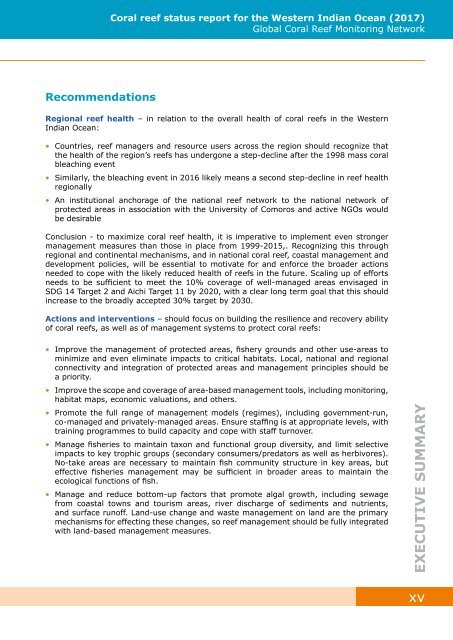GCRMN_COI_2017-Western Indian Ocean Reef Status
GCRMN Western Indian Ocean Coral Reef Status report for 2017. Produced by the Indian Ocean Commission and CORDIO East Africa
GCRMN Western Indian Ocean Coral Reef Status report for 2017. Produced by the Indian Ocean Commission and CORDIO East Africa
Create successful ePaper yourself
Turn your PDF publications into a flip-book with our unique Google optimized e-Paper software.
Coral reef status report for the <strong>Western</strong> <strong>Indian</strong> <strong>Ocean</strong> (<strong>2017</strong>)<br />
Global Coral <strong>Reef</strong> Monitoring Network<br />
Recommendations<br />
Regional reef health – in relation to the overall health of coral reefs in the <strong>Western</strong><br />
<strong>Indian</strong> <strong>Ocean</strong>:<br />
• Countries, reef managers and resource users across the region should recognize that<br />
the health of the region’s reefs has undergone a step-decline after the 1998 mass coral<br />
bleaching event<br />
• Similarly, the bleaching event in 2016 likely means a second step-decline in reef health<br />
regionally<br />
• An institutional anchorage of the national reef network to the national network of<br />
protected areas in association with the University of Comoros and active NGOs would<br />
be desirable<br />
Conclusion - to maximize coral reef health, it is imperative to implement even stronger<br />
management measures than those in place from 1999-2015,. Recognizing this through<br />
regional and continental mechanisms, and in national coral reef, coastal management and<br />
development policies, will be essential to motivate for and enforce the broader actions<br />
needed to cope with the likely reduced health of reefs in the future. Scaling up of efforts<br />
needs to be sufficient to meet the 10% coverage of well-managed areas envisaged in<br />
SDG 14 Target 2 and Aichi Target 11 by 2020, with a clear long term goal that this should<br />
increase to the broadly accepted 30% target by 2030.<br />
Actions and interventions – should focus on building the resilience and recovery ability<br />
of coral reefs, as well as of management systems to protect coral reefs:<br />
• Improve the management of protected areas, fishery grounds and other use-areas to<br />
minimize and even eliminate impacts to critical habitats. Local, national and regional<br />
connectivity and integration of protected areas and management principles should be<br />
a priority.<br />
• Improve the scope and coverage of area-based management tools, including monitoring,<br />
habitat maps, economic valuations, and others.<br />
• Promote the full range of management models (regimes), including government-run,<br />
co-managed and privately-managed areas. Ensure staffing is at appropriate levels, with<br />
training programmes to build capacity and cope with staff turnover.<br />
• Manage fisheries to maintain taxon and functional group diversity, and limit selective<br />
impacts to key trophic groups (secondary consumers/predators as well as herbivores).<br />
No-take areas are necessary to maintain fish community structure in key areas, but<br />
effective fisheries management may be sufficient in broader areas to maintain the<br />
ecological functions of fish.<br />
• Manage and reduce bottom-up factors that promote algal growth, including sewage<br />
from coastal towns and tourism areas, river discharge of sediments and nutrients,<br />
and surface runoff. Land-use change and waste management on land are the primary<br />
mechanisms for effecting these changes, so reef management should be fully integrated<br />
with land-based management measures.<br />
EXECUTIVE SUMMARY<br />
xv


















